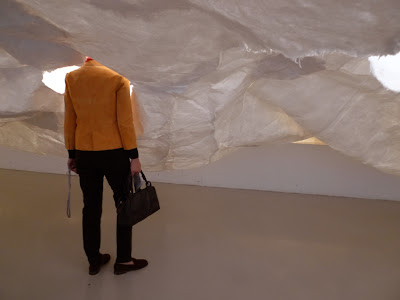Review of
the artist’s work (original title: Wald aus Wald) from the exhibition ‘Vision of Nature: Lost &
Found in Asian Contemporary Art’
Narrow doorway
before entering ‘into’ the work.
Undercurrent,
cloud or cavernous dugout before
the unravelling of forest.
Lone
viewer in observation mode.
White forest risen
from the claustrophobic space below.
‘In-between’
realm separating the polarized worlds.
Unlike
other venues in the past, the installation held in Hong Kong spills over from
one floor to another. The walk through
the exhibit is a unique addition to the experience.
The nondescript
layout of the Pao Galleries with two stories of exhibition spaces connected by a walkway
facilitates a dynamic shell for installation by the young Japanese artist – Takashi
Kuribayashi (栗林隆).
With
trepidation, one only catches a glimpse of the rugged low lying paper pulp before
entering the ethereal space. Step by
step and with head lowered, one is gradually nestled in this papier-mâché otherworldliness, the visual and
physical impacts of which are attributive to what installation art excels as a contemporary medium.
Besides material
stimulus, the visual gives rise to more profound contemplation. Kuribayashi provides
some food for thought: “I have spent a considerable amount of time developing rapport
with nature. This can be seen through my
artworks, as well as through diving and surfing. In order to preclude human from having the
wrong perception of their positions, nature teaches us how meagre we are and
how we should position ourselves in the world.” The
artist’s statement is also a reminder of the neglect of damages we inflict upon
this planet every day.
What sets this work apart from other mundane leitmotifs (in the same venue) on the theme of Nature is the
poetry and sublimity the artist manages to produce. There are a number of dichotomic forces in
operation. On the corporeal domain: undergrowth
and forest, figurative and cosmic, darkness and light, ephemeral and universal. On the emotive domain: reality and hyperreality, static
and active, apprehension and exhilaration. For an individual viewer, each condition
interacts with another whilst some transfuse among themselves to generate multiple
axioms of thoughts.
This
complex codification of messages borne out of the fragile material of
paper, itself a metaphysical attribute of tree lives in reverse making as hinted from the title of work, is admittedly
beauty to the eye. However, through the encounter
with subterranean caverns and wintry forest, one might develop a primeval sense
of insecurity as if in the great wilderness; and not before long, an awe of
nature might sink in.
I was
almost alone in the exhibition. Solitude
led to meditation on Nature. My
experience of the installation might be summed up in words by Rilke:
“In the long run, one is not as
forlorn when one is alone with a corpse as when one is alone with trees. There is something even more mysterious about
a life that is not our life, that has nothing to do with us, and which so to
speak celebrates its rite without seeing us, who watch like guests who speak a
different language.”
For those without first person experience, impressions of “Forest from Forest”
can otherwise be best attained from video clips including the following:
‘Vision
of Nature: Lost & Found in Asian Contemporary Art’ is held in the Pao
Galleries, Hong Kong Arts Centre from 10 Dec 2011 to 29 Jan, 2012.
(There is
no review on all other artists' works in this joint exhibition.)
《Forest from Forest》- 栗林隆的裝置藝術 〈中文摘要〉
令人習以為常、布局乏味的包氏畫廊终於畫出彩虹,提供了不可多得的空間環境,讓這裝置發揮得淋漓盡致。在未有心理預期下步入栗林隆的展廳時,這日本纸糊塑造出的迥異世界或許首先教人躊躇,但經過適應了狹窄及矮小的通道,頓見皚皚雪白的森林群组。誠然這一切的鋪排帶出裝置藝術作為一新興表達媒介所俱備的優勢。
除了預期視覺及感官的基層反應,作者要感染觀眾是高層次的思維:“透過我的作品,你可看到我花了不短時間試圖建立與大自然的關係;這個狀態或可在潛水和衝浪中體驗。為了遏止人類對自身既定但錯誤的看法,大自然往往會告訴我們,人類是多麽渺小,甚至需重新考量自處什麼位置。”這段話亦提醒筆者,我們每天對大地的破壞幾乎達到坐視不理的狀態。
相對此創作與其他以大自然為題的在場木訥藝術作品,它一方面充滿詩意,另外特別是它攝人的景意令人朝內裡深省。查這纸糊作品內擁多個二元力量互相引動,孕育變化。在物質領域上:地壤與林木、具象與穹宇、黑暗與光明、幻化與恆常;在感性領域上:現實與超現實、静態與動態、忐忑與快慰。觀者通過個人觸覺去領悟作品,融會上述力量或其他因素,產生多層次的觀後感。
宏觀整個創作,闢除它發放的複合信號,不能否認它俱相當的美觀性。但細味經歷現場深沉的洞穴和冰冷般的森林後,讓觀眾引發出人類對原始環境的不安;也許迅間,對大自然的敬攝亦暮然湧至。
參觀當日人跡罕見,筆者由寂靜中感動,引發對大自然的沉思。此間,德國詩人里爾克對大自然敬畏之著墨正好代表個人的整體感受。〈由於找不出詩篇的中文版,只好冒險翻譯,建議讀者用英文版本補充不善之處。〉
“假以時日,一個人與死屍獨處也沒有比與樹林獨處更蕭瑟悲凉。這裡擁有較我們生命更神秘的生命;牠們既不干涉我們,亦不曉望我們,只贊頌自己的祭禮;牠們凝視的目光尤如訪客,話說他方語言。”
若然錯過了或希望重温展品,上方備有錄像連結供讀者感受。
《Forest from Forest》屬《重新審視自然:亞洲當代藝術中的自然》聯展一部份,由二O一一年十二月十日至二O一二年一月二十九日于香港藝術中心包氏畫廊展出。
〈筆者沒有對同場其他藝術家作品置與評論〉



























